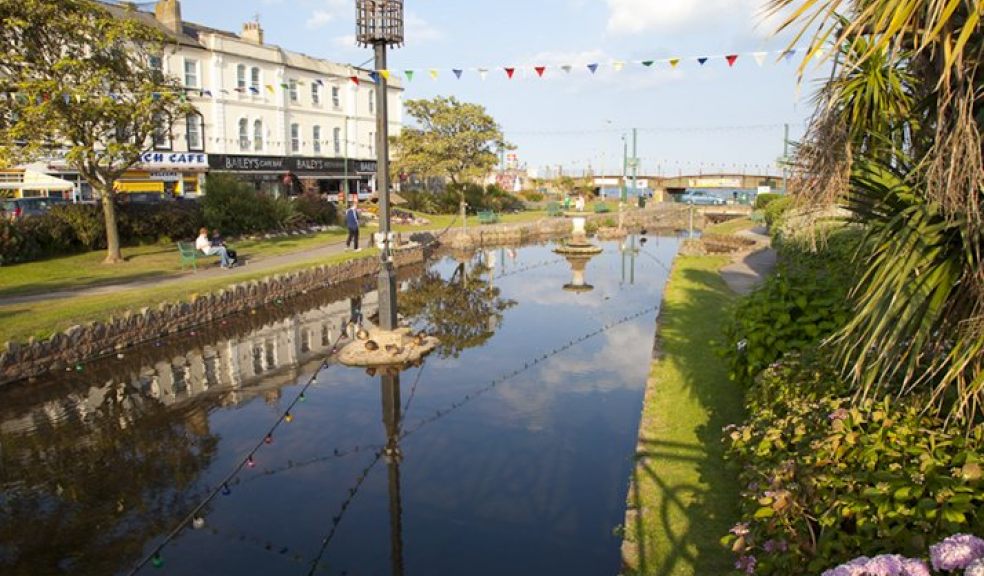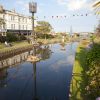
Dawlish flood prevention work begins
De-silting work is about to start on Dawlish Brook to help reduce future flooding, protect the town centre, residents and businesses and its world-famous waterfowl.
Work is scheduled to start on today (12 November) and is set to last two weeks.
Signs have been put up at the waterfowl warden’s building and the Tourist Information Centre to tell people what is happening.
Dawlish Brook, also known as Dawlish Water, begins its journey at Haldon and runs through Ashcombe valley, before reaching the sea at Dawlish Beach. On its journey it drops over weirs and under bridges, passing through the Manor Gardens and the Lawn, eventually joining the sea, passing under the railway viaduct.
The Brook has 20 weirs and sluices along its length. Work is needed because over the years - and in particular last year’s storms - silt and gravel have been washed downstream, creating build-up to an unacceptable level.
This leaves the Lawn prone to flooding which has an effect on residents, businesses and the nesting birds.
Teignbridge District Council, the Environment Agency, Devon County Council; and Dawlish Town Council are working together to look at the way water flows along Dawlish Brook and how this flow affects the town, particularly during periods of flooding.
The long-term and detailed project looks at dealing with any problems found and making adjustments where necessary.
The main problem is the build-up of silt and stone. Work has focused on how the weirs gates may be altered to reduce this.
Engineers are also looking at where the silt and stone material has come from and how all the partners can manage this better.
The programme of works will start off with a ‘fish rescue’ by the Environment Agency, prior to a de-silting exercise.
The weir gates will be opened to help reduce flooding and also self-flush The Brook. Accumulated material which can clog up the watercourse will be removed from lower bays. Bays from the bandstand and above contain larger size gravel material which provides ideal habitat for spawning fish. For this reason those bays will be looked at in greater detail when fish spawning season finishes next April.
Any material that is removed will be reused to restore river banks that were lost in the 2012 floods at Ashcombe.
Cllr Kevin Lake, Teignbridge District Council’s Executive Spokesperson for Environmental Services, said: “The dredging work is really important because it will help stop the Lawn from flooding.
“Reducing the impact of contamination and pollution of bathing waters in the UK is an essential piece of work that Teignbridge and its partners take very seriously.
“The Lawn is unique and is an important meeting point and recreational area for residents and visitors. And, of course, it is home to the black swans and waterfowl, adored by many and which give Dawlish its unique identity.”
Cllr Graham Price, Teignbridge Ward Member for Dawlish Central and North East, said: "It is wonderful news that at last the desired clean up of the Brook is about to take place. The residents of Dawlish will be delighted as the present situation has been a cause of concern for some time. Because of the complexity of the project we appreciate it has had to take time to ensure the correct course of action is applied."
Cllr Ted Hockin, Teignbridge Ward Member for Dawlish Central and North East, said: "Dredging the Brook is to be welcomed as it will help give security by preventing flooding of properties around the Lawn and will certainly make the area more attractive and look less neglected.
"With the work on the Strand now almost completed and the dredging of the Brook about to take place, the centre of Dawlish is becoming an even more attractive place to live in and visit."
Councillor Stuart Hughes, Devon County Council Cabinet Member for Flood Prevention, said: "It's encouraging to see how well the authorities are working in partnership to reduce the risk of future flooding in Dawlish. The Defra Community Resilience Pathfinder project, being led by the County Council, has provided us with the opportunity to work closely with the local community and assist them with the development of their local action plan."
The Environment Agency’s Environment Officer Nigel Thomas-Childs said: “This work brings together months of planning behind the scenes and working with farmers and landowners upstream of the town. The fish rescue will also provide useful background data about the fish species and fish numbers present in the Brook.”
On behalf of Dawlish Town Council, Dawlish Mayor Cllr Terry Lowther, said: "I'm delighted to see progress towards attaining one of the Town Council's main aims. After the Lawn, the Brook is the biggest attraction in the town and is very important to visitors and residents alike. It also plays a vital function in reducing the risk of flash floods."
Future work will also involve trialling a light-weight weir gate as an alternative to the existing heavier metal types, fully repairing a weir near the bandstand, removing sediment and gravel and improving an island opposite the Old Post Offices to help protect the swan nesting site. The deep fast-flowing section of river is also beneficial for fish.
Repairs will also be made to the island opposite the bandstand to help protect the waterfowl site and design work on new, large size weir gates in the last two weirs will also be progressed.
In the meantime work will continue with the new Dawlish Emergency Response Plan which outlines actions to be taken before, during and after a flood event.
For more information visit www.teignbridge.gov.uk/dawlishwater

















